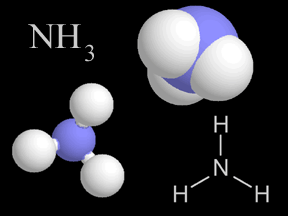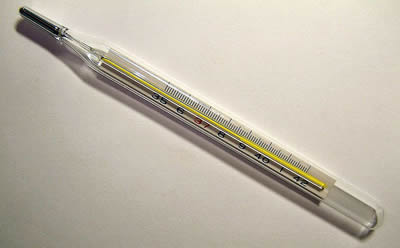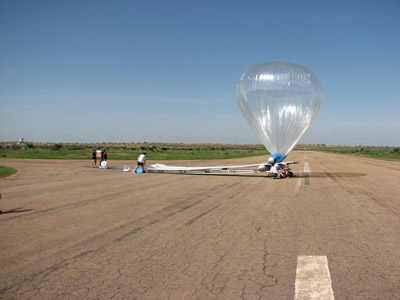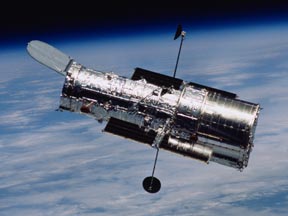The exosphere is almost a vacuum. This picture shows the Hubble Space Telescope orbiting Earth in the exosphere. Places that are lit by sunlight are very hot. Places in the shade are very cold.
Click on image for full size
Image courtesy NASA.
Temperature in the Exosphere
The exosphere is almost a vacuum. The "air" is very, very thin there. When air is thin, it doesn't transfer much heat to objects in the air, even if the air is very, very hot.
One definition scientists use for temperature is the average speed of the molecules or atoms in a gas. When the particles are moving very fast, the temperature is hot. When particles are bouncing around more slowly, the temperature is cooler. The particles in the exosphere are moving very quickly, so the temperature there is quite hot. However, the exosphere would feel quite cold to us. How can that be? Since the "air" is so thin in the exosphere - it is almost a vacuum - there are very, very few particles. We feel warmth when particles hit our skin and transfer heat energy to us. There are too few particles in the exosphere to transfer much energy, even though each particle is quite "hot" itself.
Objects in the exosphere are hot if lots of sunlight shines on them. Sunlight is very, very bright up there, so objects in the sunshine heat up quickly. However, objects in the shade can get really, really cold. For example, one side (the sunny side) of a satellite might be very hot, while the other side (in the shade) might be freezing cold.
You might also be interested in:

Most things around us are made of groups of atoms bonded together into packages called molecules. The atoms in a molecule are held together because they share or exchange electrons. Molecules are made
...more
Rainbows appear in the sky when there is bright sunlight and rain. Sunlight is known as visible or white light and is actually a mixture of colors. Rainbows result from the refraction and reflection of
...more
The Earth travels around the sun one full time per year. During this year, the seasons change depending on the amount of sunlight reaching the surface and the Earth's tilt as it revolves around the sun.
...more
Scientists sometimes travel in specially outfitted airplanes in order to gather data about atmospheric conditions. These research aircraft have special inlet ports that bring air from the outside into
...more
An anemometer is a weather instrument used to measure the wind (it can also be called a wind gauge). Anemometers can measure wind speed, wind direction, and other information like the largest gust of wind
...more
Thermometers measure temperature. "Thermo" means heat and "meter" means to measure. You can use a thermometer to measure the temperature of many things, including the temperature of
...more
Weather balloons are used to carry weather instruments that measure temperature, pressure, humidity, and winds in the atmosphere. The balloons are made of rubber and weigh up to one kilogram (2.2 pounds).
...more















